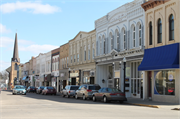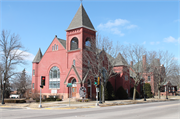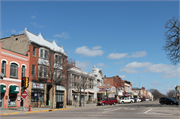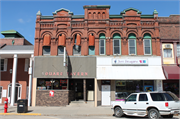Baraboo Downtown Historic District
Bounded by 5th Avenue, 5th Street, Ash Street, 1st Street, Oak Street, 2nd Avenue, and Birch Street, Baraboo, Sauk County
Dates of Construction: 1872-1966
Architects: Claude, Louis & Starck, Edward Clas, Alfred & Ferry, George Rapp & Rapp
Downtown Baraboo is notable in its prevalence of late nineteenth and early twentieth century commercial buildings arranged in a cluster around the central Sauk County Courthouse Square. The district consists of commercial storefronts and a few civic and religious buildings set in an aligned grid of city blocks and alleys. The exception being blocks dedicated to civic functions such as the public courthouse square and the site of the old Baraboo High School.
The district’s development began in the 1840s and continued for over a century, with a concentrated period of development in the 1880s, 1900s, and in the post-war period, and has served as the active commercial core for the City of Baraboo. By the time Baraboo was incorporated as a Village in 1865, the initial milling and lumber economy tapered off and was replaced by a trading center for the successful agricultural region that surrounded it. A second period of rapid development took place in the 1870s and 1880s with the arrival of the railroad, making Baraboo a major distribution point. A third wave of development took place after the turn of the twentieth century through the growth of various types of tourism and the base of the circus industry. In post-war years, Baraboo remained a commercial destination for a consumer economy.
Representative of the march of prevailing architectural tastes of the era in which they were constructed, Italianate, Commercial Vernacular, Art Deco, and Contemporary styles are prominent within the district. The buildings within the Downtown Baraboo Historic District are well preserved and have much of the same appearance today as they did when they were originally constructed. The result is one of Baraboo’s most architecturally intact historic commercial areas. |





